A Guide To Backpacking The Hoh Rainforest In Washington State
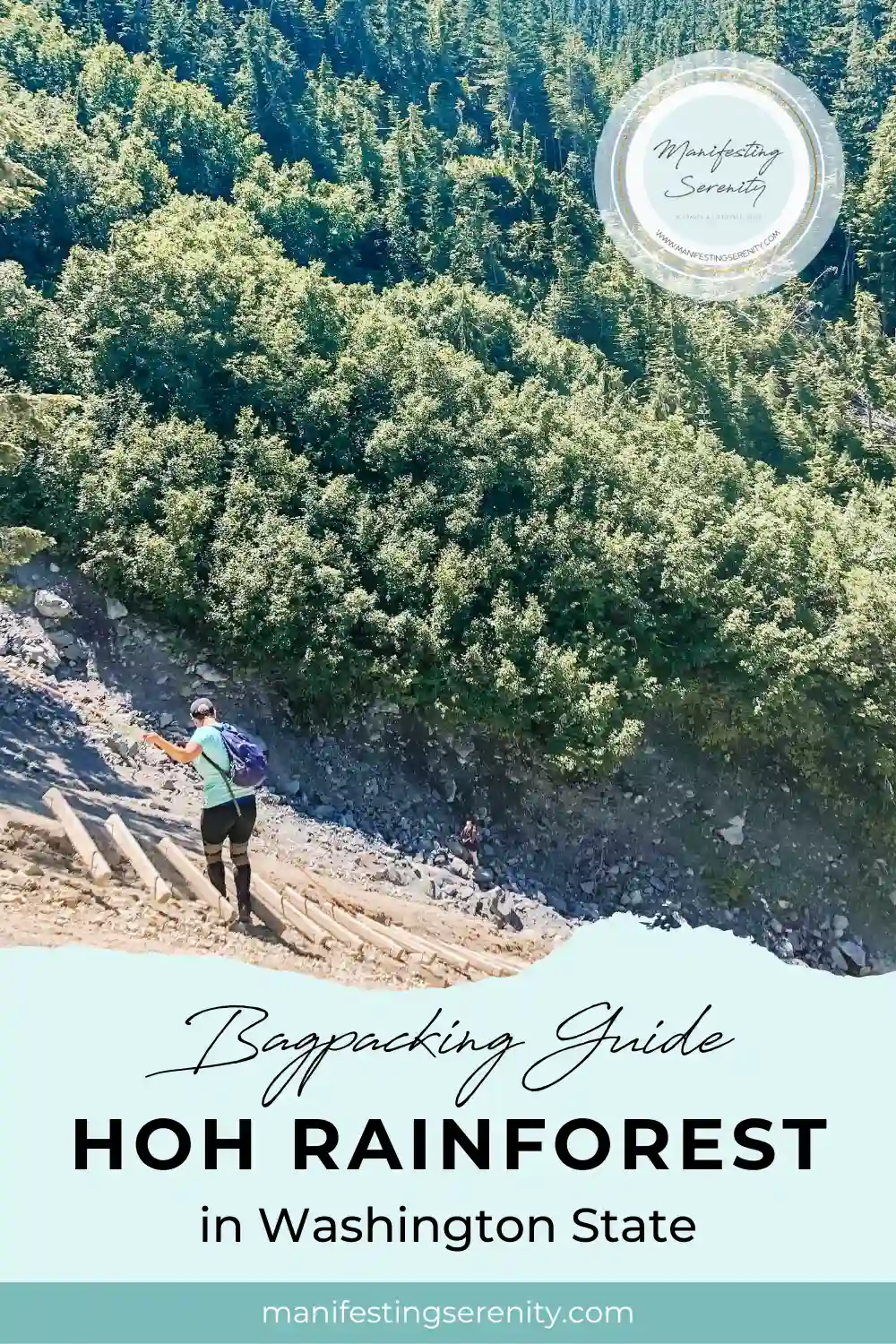
The Hoh Rainforest, pronounced “Ho”, yes I know it can be a little uncomfortable to say at first, derived its name from a word that means “fast-moving water” or “snow water” in Native American Cultures.
Fun fact alert: incidentally, there is a river that comes from the glacier run-off, so it matches up with the name well! Isn’t that awesome?
Plus, another fun fact: Did you know that the Hoh Rainforest averages 140 inches (3.5 meters) of rainfall in the winter? That’s precisely why it’s teeming with lush, green goodness. So don’t forget to prepare for the rain when you go!
Come rain or shine, anyway, this was definitely one of the most memorable trips I have ever done in Washington! Backpacking the Hoh Rainforest is truly an experience I cheer on everyone to add to their bucket list.
So, pack your sense of wonder, grab a sturdy backpack, and let the Hoh Rainforest weave its enchantment around you. Coming from someone who lived there for 20 years, trust me, this is a journey you won’t want to miss!
Washington Travel Resources Key
All resources on our site are shared to fuel and inspire you to be able to confidently, courageously, and sustainably explore this beautiful world. Here are some resources for before and after your trip!
Table of Contents
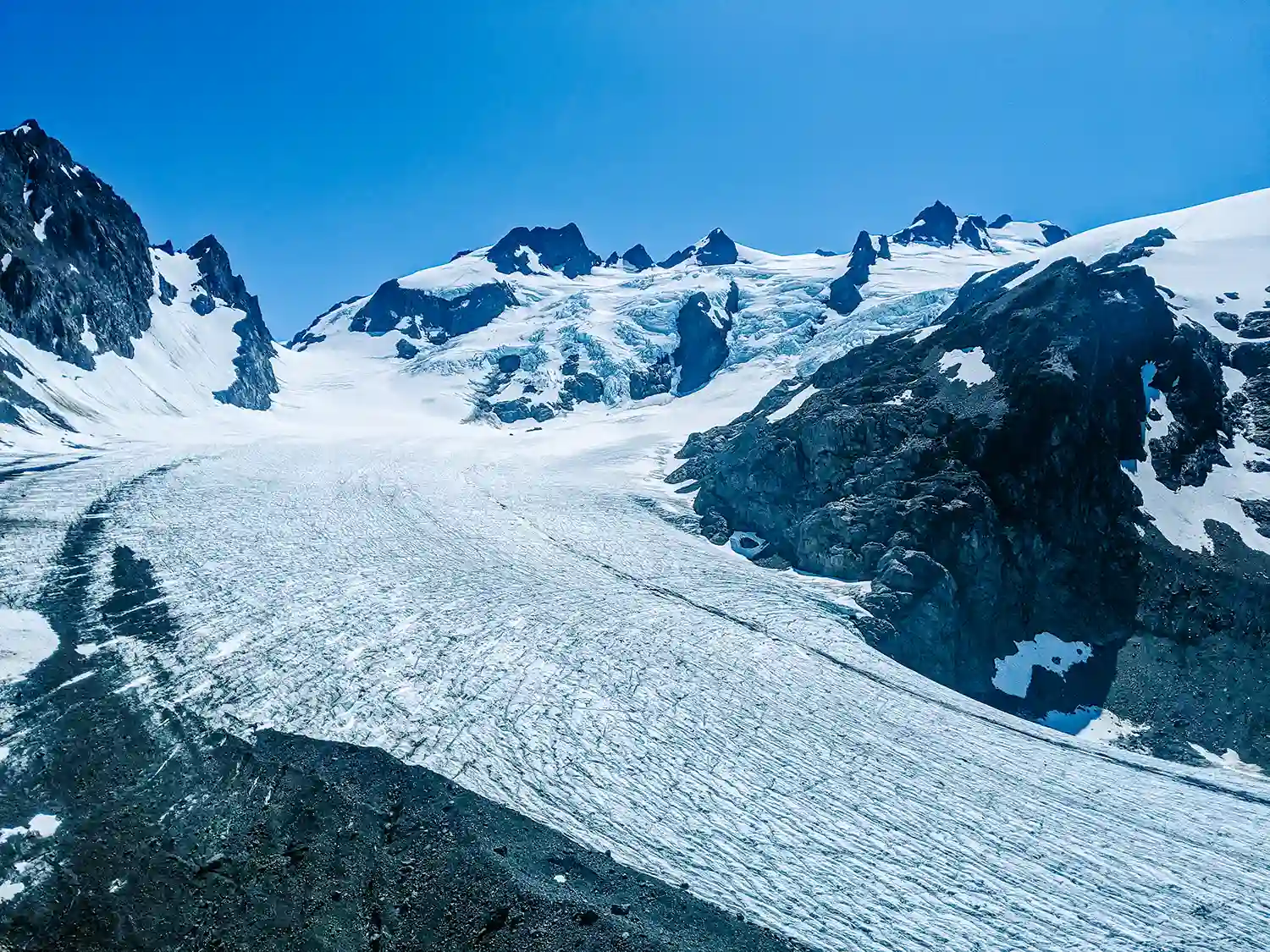
Best Times to Go to Hoh Rainforest
Remember, no matter the season, the Hoh Rainforest is always ready to greet you with open arms and a touch of mystery. The Olympic National Park, which covers the Hoh Rainforest is open 24 hours a day year-round, although some roads, campgrounds, and facilities are open on a seasonal basis.
The best time to embark on a backpacking adventure here depends on your preferences and the kind of experience you’re seeking. Let’s break it down:
Spring Fling (April to June)
From April to June, nature puts on a dazzling show, revealing a kaleidoscope of colors that will make your heart skip a beat. Picture vibrant blooms, fresh foliage, and a chorus of birds serenading your every step. Springtime in the Hoh Rainforest is like stepping into a fairytale. It’s the perfect time to witness the forest awakening from its winter slumber.
Spring marks the end of the rainy season, and the Hoh Rainforest starts to bloom with vibrant greenery and a burst of wildflowers. The temperatures are moderate, making it a pleasant time for backpacking. However, the trails can still be quite muddy from the previous rains, so be prepared with waterproof gear and sturdy hiking boots.
Summer Splash (July to September)
When the temperature rises and the sun beams down, the Hoh Rainforest transforms into an oasis of coolness and adventure. Grab your sunblock, don your shades, and prepare to explore the shaded trails under the lush canopy. Summer is the season of exploration, where hidden waterfalls, crystal-clear streams, and delightful wildlife encounters await your curious gaze.
Summer is the peak season for visitors, as the weather is relatively dry and temperatures are warmer. The trails are more accessible, and the forest is alive with lush foliage. But keep in mind that this is also the busiest time, so if you prefer a quieter experience, you might want to plan your trip for early summer or weekdays.
Personally, I’d prefer either June or July, to experience the wildflowers, butterflies, and mini waterfalls along the way.
Autumn Magic (October to November)
Ah, the crisp air, the crunch of leaves underfoot, and the magical dance of colors that engulfs the forest. Autumn paints the Hoh Rainforest with warm hues of red, orange, and gold, creating a mesmerizing spectacle that nature lovers simply can’t resist. As the days grow shorter, take a leisurely stroll through the trails and revel in the breathtaking beauty that surrounds you.
Fall is a quieter time in the Hoh Rainforest. The crowds have thinned out, and the forest takes on a magical transformation with the changing colors of the leaves. The temperatures start to cool down, and you’ll want to be prepared for some rainy days.
Winter Wonderland (December to March)
Brace yourself for a winter adventure that will make your inner explorer rejoice! While the Hoh Rainforest may not be a snowy wonderland, it still holds its own unique charm during the colder months. With fewer crowds and a serene atmosphere, you’ll feel like you have the forest all to yourself. Bundle up, embrace the misty ambiance, and witness the forest’s quiet majesty as it slumbers under a gentle blanket of fog.
Winter brings a different kind of beauty to the rainforest. The mosses and ferns are even more vibrant, and the forest feels almost otherworldly in the mist. However, this is the wettest season, so be ready for heavy rainfall. The plus side is that you’ll have more solitude, as fewer people venture into the rainforest during this time. Although winter is beautiful and can be peaceful, be sure to go online and ensure that roads are open, and ensure that you have the right winter clothes and gear to truly enjoy.
In terms of logistics, it’s a good idea to check the weather forecast and trail conditions before you go. Keep in mind that the Hoh Rainforest receives an average of 140 inches (3.5 meters) of rain per year, so waterproof clothing and gear are essentials no matter when you visit. Also, make sure to obtain any necessary permits and reservations if required for camping. Ultimately, the best time to go to the Hoh Rainforest for backpacking depends on your personal preferences for weather, crowd levels, and the kind of natural beauty you want to experience.
So, get out there and immerse yourself in the beauty, charm, and wild spirit of this extraordinary place.
How To Get To The Hoh Rainforest
Nestled within the enchanting Pacific Northwest, the Hoh Rainforest emerges as a vibrant jewel.
Once part of a vast expanse of rainforest stretching from Alaska to California, this majestic destination stands as a testament to the enduring beauty of temperate rainforests in the United States. It’s no wonder that the Hoh Rainforest is a beloved highlight within Olympic National Park.
Located on the western side of the park, the Hoh Rainforest is just a scenic two-hour drive from Port Angeles or less than an hour from Forks. To embark on your adventure, follow Upper Hoh Road, conveniently connected to Highway 101. Keep your eyes peeled for the signs!
If you’re seeking helpful information on facilities, picnic areas, camping options, and park regulations, fear not! The park’s brochure is your trusty guide to backpacking the Hoh Rainforest. Inside, you’ll discover a handy map to orient yourself and make the most of your visit to this natural wonderland.
Backpacking the Hoh Rainforest will surely leave you with unforgettable memories!
If you’re coming from the North
This area is easiest accessed by ferry if coming to this part of Washington from the north or the east. For those that are south coming north, the easiest route is just driving straight there.
If you’re coming from the East
If coming East; from downtown Seattle, drive onto the Seattle-Bainbridge Island ferry or the Seattle-Bremerton ferry;
We’ve gone ahead and compiled the resources that you’ll need for the ferry trips. If you are taking the Seattle-Bainbridge Island ferry, you may check their departure and arrival times here.
However, if you intend to take on the Seattle-Bremerton ferry, here’s a link to their schedule.
If you’re from the Northern Suburbs
And finally, if you’re coming from the north, the Edmonds-Kingston ferry is the quickest. For their daily trip schedule, you may visit this link.
Coming from Canada
If you’re coming from Canada, Black Ball Ferry runs four times daily in summer between Victoria, BC, and Port Angeles.
Learn about the schedule of their trips and fare rates here.
Here’s another scoop: Make sure to keep a weather eye on the ferry’s scheduled time, the boarding time, and the ever-so-crucial unload time.
Getting a Pass and Permit
The campground within the Hoh Rainforest offers a total of 72 sites nestled among the ancient trees and alongside the tranquil river.
For backpacking the Hoh Rainforest, a special Wilderness permit is needed. To obtain Wilderness backpacking permits, advanced reservations are now required as self-registration and trailhead permits are no longer available.
First, visit the Olympic National Park Wilderness Permit page to create your permit. When it comes to applying for a permit, the best chances of obtaining one are about 3 months in advance, as that’s generally the soonest they become available.
Ensure to take note of your starting point, camp spots, and endpoint. When it comes to finding those, it’s best to reference the National Park’s map, HERE.
Next is getting your permits in hand, reserved permits are issued 5-7 days before your trip, which you can print from your account or pick up in person at the Wilderness Information Centers. Please note that they must be attached to your pack. If you get stopped by a ranger and you don’t have them on hand, you could be escorted off the trail and/or ticketed.
Additionally, bear canisters are required in many camp areas and are loaned on a first-come, first-served basis to permit holders. Although it’s great to use one of theirs, it’s also nice to have the backpacking pack already pre-packed and ready to go, without having to guess ahead of time before stuffing as much as you can into getting the last-minute bear canister. Check out these bear canisters HERE!
Lastly, it pays to stay updated on wilderness conditions by visiting the trail conditions page and remembering to practice Leave No Trace ethics for preserving the backcountry’s pristine beauty.
As an eco-conscious adventurer, please take note that some areas have specific seasons based on snow conditions. As well as prepare for as much as you can.
Fees & Payments
Get ready for the next step in the journey from your trusty guide in backpacking the Hoh Rainforest!
To start off, backpacking fees for the Hoh Rainforest are around $8 per night for adults (16 and older), while youth (15 and under) camp for free. Please note that these prices may change accordingly and double-check the rates.
Additionally, there will be an entrance fee. In case you didn’t know, the Annual Wilderness Pass/ Annual National Park Pass, priced at $80 per person, which covers entrance fees for all National Parks. But without it, the entrance fee for just one National Park is typically $30-$40 per entry. So, getting the annual pass is definitely worth it!
Plus, these fees contribute to visitor management projects and support facilities and services in the wilderness area.
What To Pack For Backpacking
Your gear either supports or limits your experience!
Choosing the right equipment can make all the difference between a memorable journey and a challenging trek. I speak from experience when I say that the simplest things can be easy to overlook until you’re out on the trail.
Examples:
The wrong pack can mean that it’s off weight, affecting your body balance, or can’t hold everything that you need.
Having a sleeping bag that’s not warm enough can impact your sleep, not allowing you to fully recover and be ready for the next day’s trek!
Not sure where to start? I’ve got expert tips and honest reviews to guide you through making the best choices for your next adventure. Trust me, investing in the right gear can mean the difference between loving every moment on the trail and counting down the minutes until you’re back home!
Be prepared and ready for any backpacking trip – or even find a new favorite!
Day 1: Prepping for the Trip
The Hoh River Trail is the area’s main hiking and backpacking trail. This out-and-back trail can be taken as far as one desires. Taken all the way, it leads past multiple camping areas, the last being Glacier Meadows at 17.3 miles (27.8 km), and ultimately ends 18.5 miles (30 km) out at the Blue Glacier moraine looking up at Mt. Olympus.
For our first night, we stayed overnight at the Olympic National Park campground in loop C 71, on July 23rd. (I’m sharing the date so that you can get an accurate display of the timeline within the photos!)
We spent the night prepping & weighing our packs, double-checking our gear, and assessing what we truly needed! It’s important to know how to prep your pack, ensuring to stay under 15-25% of your total body weight. We used this scale to weigh our packs!
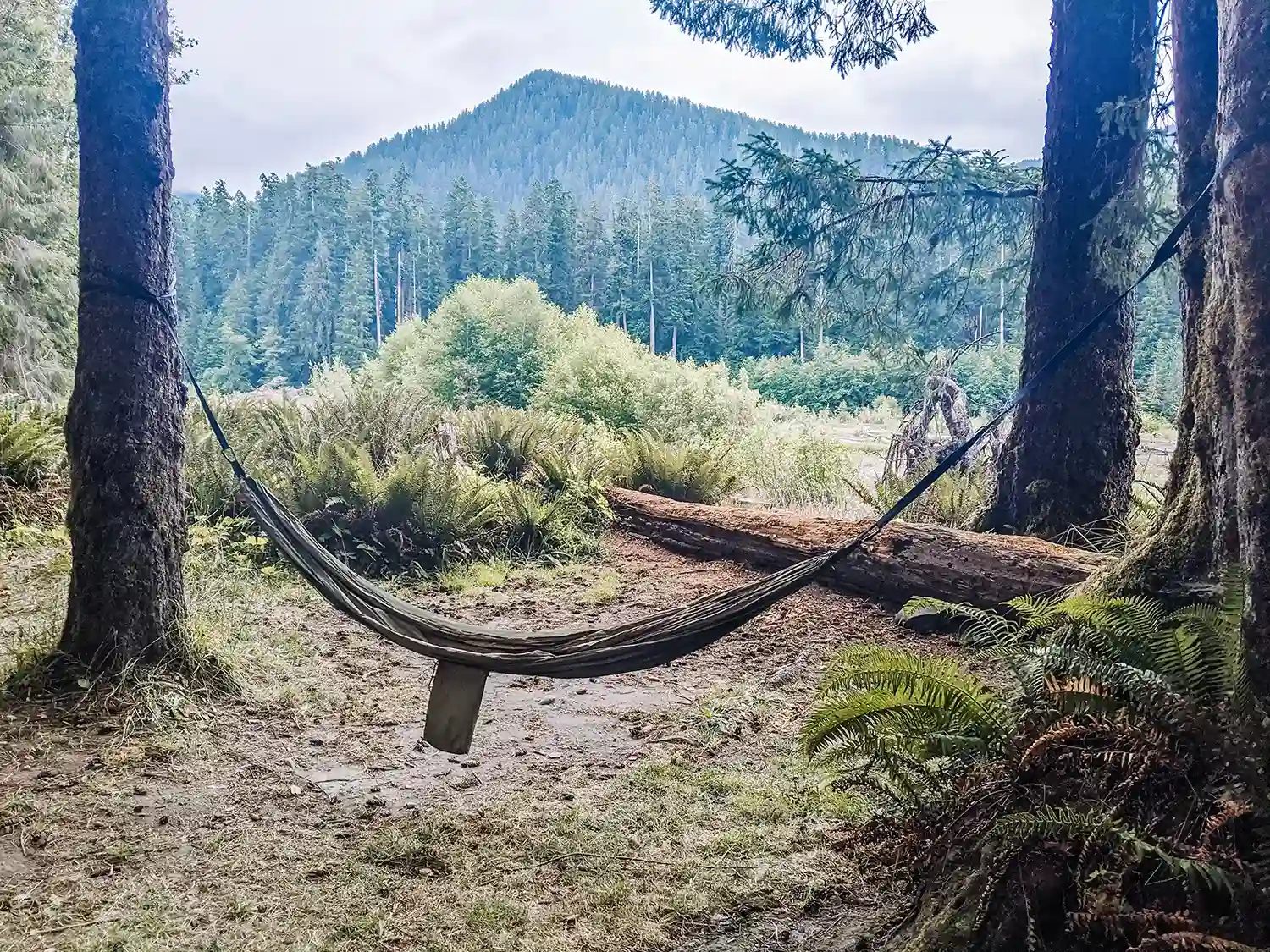
Day 2: Backpacking To Lewis Meadow
The next day, the plan was to backpack to Lewis Meadow, which is an average of about 10 miles (16.09 km).
This was a super beautiful and flat hike through meadows and beautiful views of ancient and massive trees! Absolutely amazing, little streams and small waterfalls filled the silences. This is an amazing time to breathe, unwind and realize you are on one of the most beautiful trails in Washington!
Also, don’t forget to keep up on caring for your body! Some people only complete the first 10 miles (16.09 km) , and that is totally okay! So do what you can and be grateful for the experience regardless of what you completed!
Lewis Meadows was an amazing camping spot, secluded with only a short distance from the river. Which was great for pumping water, soaking our feet, and the toilets! Funny enough, toilets are a complete luxury when backpacking! HA!
What’s even more delightful, this spot was also filled with deer that would just graze gracefully in the morning, completely unfazed by humans. Such a gorgeous sight to wake up to!

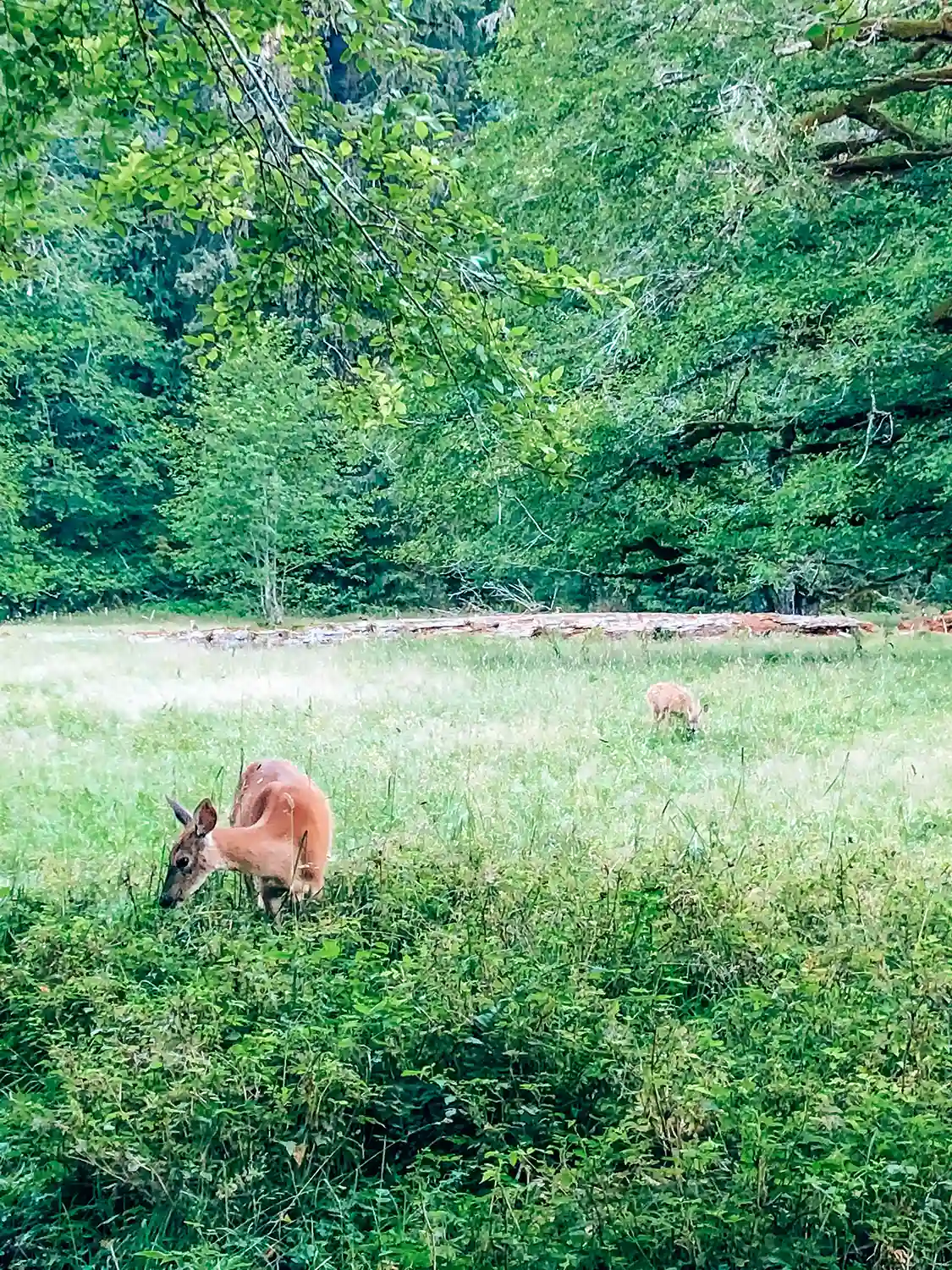
Day 3: Witnessing Blue Glacier Moraine’s Glory
Let’s dive into day three of our epic expedition of backpacking the Hoh Rainforest! Our blueprint for this day was to get on a thrilling hike from Lewis Meadows to the whimsical Blue Glacier Moraine.
Planning the Day
The game plan was to kick off the day with an early-morning escapade! We readied ourselves to rise and shine at the delightful hour of four am (yes, you read that right) and aim to hit the trails by around five-ish. Why, you ask? Well, it’s all about striking that perfect balance.
This way we could try to avoid as much of the heatwave as possible but not be hiking in the dark for long in the morning, avoid having to hike in the dark later that evening.
I don’t recommend hiking in the dark because more predators are out, it’s harder to gauge where you are on the trail, and you are more likely to get injured because of it. Plus, it’s best to admire them from a safe distance. So, let’s save those encounters for daylight hours, shall we?
Plus, making time for breakfast is essential! So, we ate our breakfast, gathered our lunches and snacks for the day, and headed out.
Heading to the Glacier
For those that want to enjoy the glacier longer or even know they’re in pretty good shape, I would have recommended backpacking up to camp out at Elk Lake on either the first or second night. As Lewis Meadows is around 10–12 miles in, then Elk Lake is an additional 7–9 miles more or so! Which would have made for a much shorter hike to the glacier in the morning. (Please refer to the disclaimer at the bottom of the article.)
Plus, the elevation only just started to get intense after Elk Lake, getting to about a 2670 elevation gain. It’s like climbing a colossal staircase with 2,670 steps, each step bringing you closer to breathtaking views!
But you better brace yourself, because the elevation continued to increase gradually across the day leading up to the Glacier. So we had about 21-24 miles (there and back) to hike this day (this mileage is even harder to gauge because it truly depends on which direction you took to go up to the basin of the glacier!).
The Ladder Them Empowers
As originally planned, we were actually supposed to backpack all the way up to glacier meadows. But in a delightful surprise, I am so happy we didn’t end up doing that!
Imagine a scene where we take our heavy packs up and down a landslide with that rickety, broken ladder! It would have been way too intense for me and I would have felt so unsafe! Can you imagine that towering ladder at Glacier Meadows standing a mighty 30 feet (9.14 meters) tall and each rung seems like a delicate stepping stone?
Picture it: a ladder crafted from weathered timber, worn by time and weather, but still standing, ready to take on thrill-seeking, courageous, determined, and of course, physically and mentally prepared adventurers.
Just so you know, Glacier Meadows has about a 4300 elevation gain, so beyond that, the elevation drastically increased. It’s like traversing through the scenic beauty of the Swiss Alps or the Himalayas!
So, stopping before the ladder is also totally okay, and there is even a beautiful peekaboo view of the mountains too. Although I must say that the trek is worth getting all the way up to the very top of the mountain, this can be a very challenging section and beyond. Please first mentally prepare yourself and be your best advocate.
SUBSCRIBE AND JOIN THE COMMUNITY ♡
You’ll also be the first to hear about everything new and juicy, stuff you’ll probably want to know about: Website updates, new products, new articles, inspiration, promotions, and even giveaways!! (You don’t want to miss out on those!) Giveaways can be products, trips, subscriptions and so much more!
Welcome! ♡
You have successfully joined our subscriber list, be on the lookout for your welcome email! ♡

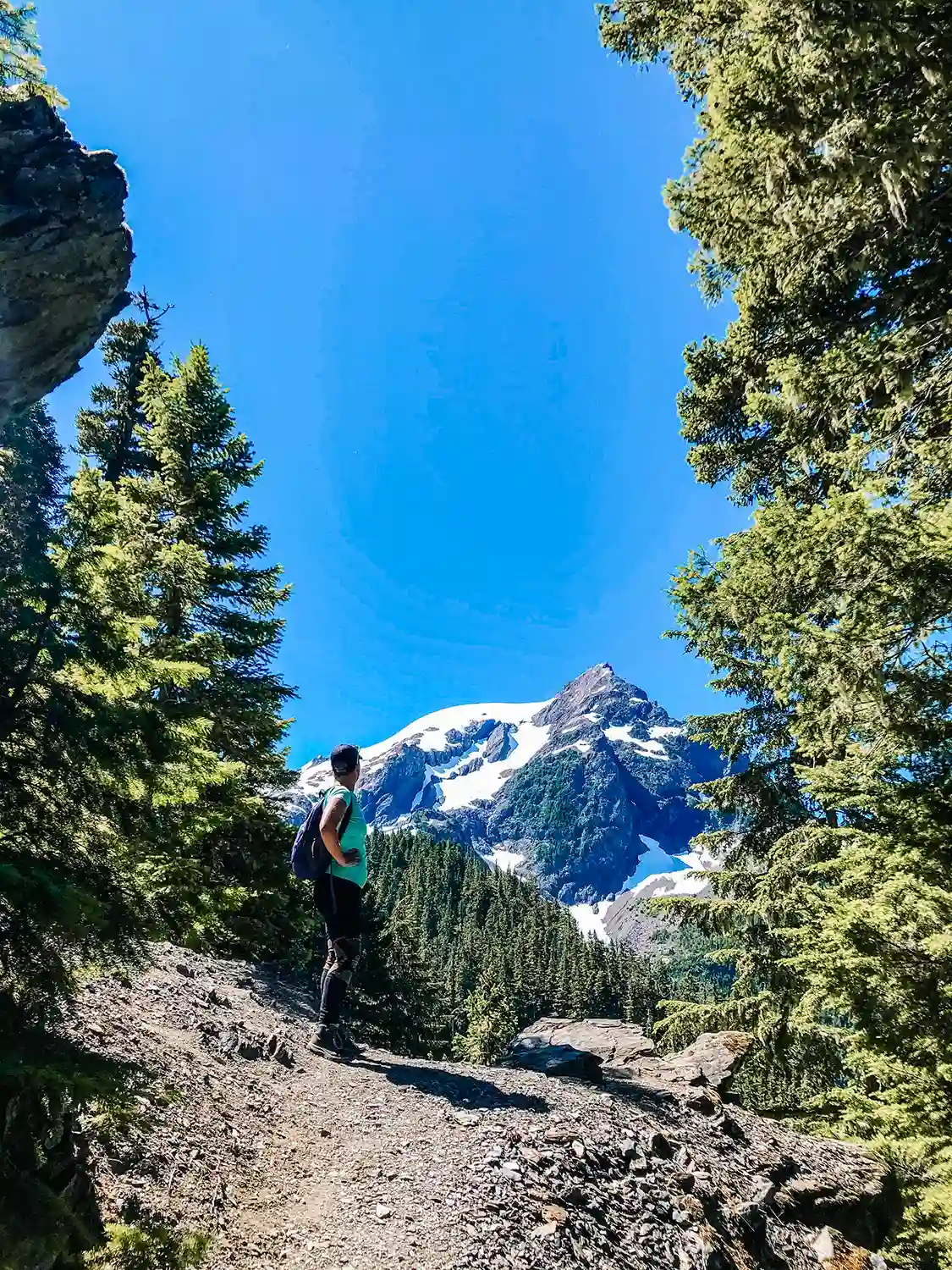
Lateral or Vertical View? You Choose Your Glacier View!
Did you know that there are two options that you can choose from? Yes! You can opt to choose the lateral or vertical view of the Blue Glacier Moraine.
Vertical Trail
The hike begins with a gradual ascent, leading you through lush forests and meandering paths. The air is crisp, and the sounds of nature envelop you, creating a serene atmosphere. As you continue onward, the trail gradually becomes steeper, demanding more effort and endurance.
As you go along, the terrain transitions from well-maintained trails to rocky sections and occasional scrambles, adding an exciting element of adventure to the hike. The trail meanders through alpine meadows, offering glimpses of vibrant wildflowers and the occasional wildlife sighting. It’s as if you’re being rewarded after a challenging hike!
Now, here’s where things really get epic, as you gain elevation, the panoramic views start to unfold. Each step brings you closer to the vertical view of Blue Glacier Moraine, where the sight of the glacier’s icy expanse against the rugged mountains will leave you in awe.
Amazingly enough, you’ll see steep cliffs, deep crevasses, and cascading ice formations that create a dramatic backdrop that showcases nature’s artistic prowess!
Reaching the vertical view is a moment of triumph and reward. You can pause to catch your breath, take in the majestic scenery, or just thank yourself for backpacking the Hoh Rainforest!
Lateral Trail
Meanwhile, the lateral trail promises a blend of rugged terrain and awe-inspiring views.
As you set off on the hike, you’ll find yourself traversing through diverse terrain. The trail winds its way through rocky slopes, meandering streams, and patches of alpine vegetation. The sound of rushing water and the occasional crackling of ice create a soundtrack of nature’s symphony.
With every step, the path gradually gains elevation, providing glimpses of the lateral view as you ascend. The glacier looms larger, and the sheer scale of the icy formation becomes apparent. The lateral view reveals the striking contours of the glacier, displaying its intricate network of crevasses and seracs.
The trail may require navigation over rocky outcrops and boulder fields, adding an element of adventure to the hike. Along the way, you may encounter small glacial lakes nestled in the rugged landscape, reflecting the surrounding peaks and adding to the picturesque scenery.
As you approach the lateral view, you’ll be captivated by the raw power and beauty of Blue Glacier. The brilliant blue hues of the ice contrast against the rocky backdrop, creating a breathtaking sight that’s both majestic and humbling.
Reaching Glacier Glory!
Using all of my senses, I will do my best to describe it for you, but backpacking the Hoh Rainforest is truly something to experience.
Hearing the gusting winds. Feeling the warm breeze off of the basin rocks intermixing with the icy breeze that rolls off the snow from the glacier itself, grazing each side of your body, feeling the shift in temperatures.
Plus, as if that wasn’t enough…the sweet and sour taste from the berries still lingering in your mouth, as your jaw drops from disbelief.
Eyes gazing back and forth, not sure where to rest, as the sunlight bounces off the white and blue hardened snow, brightly glistening.
Oh, and we can’t leave out the scent of the flowers still lingering, not wanting to release that delightfully sweet aroma.
Such a state of pure bliss and serenity up in the Glacier’s full glory!
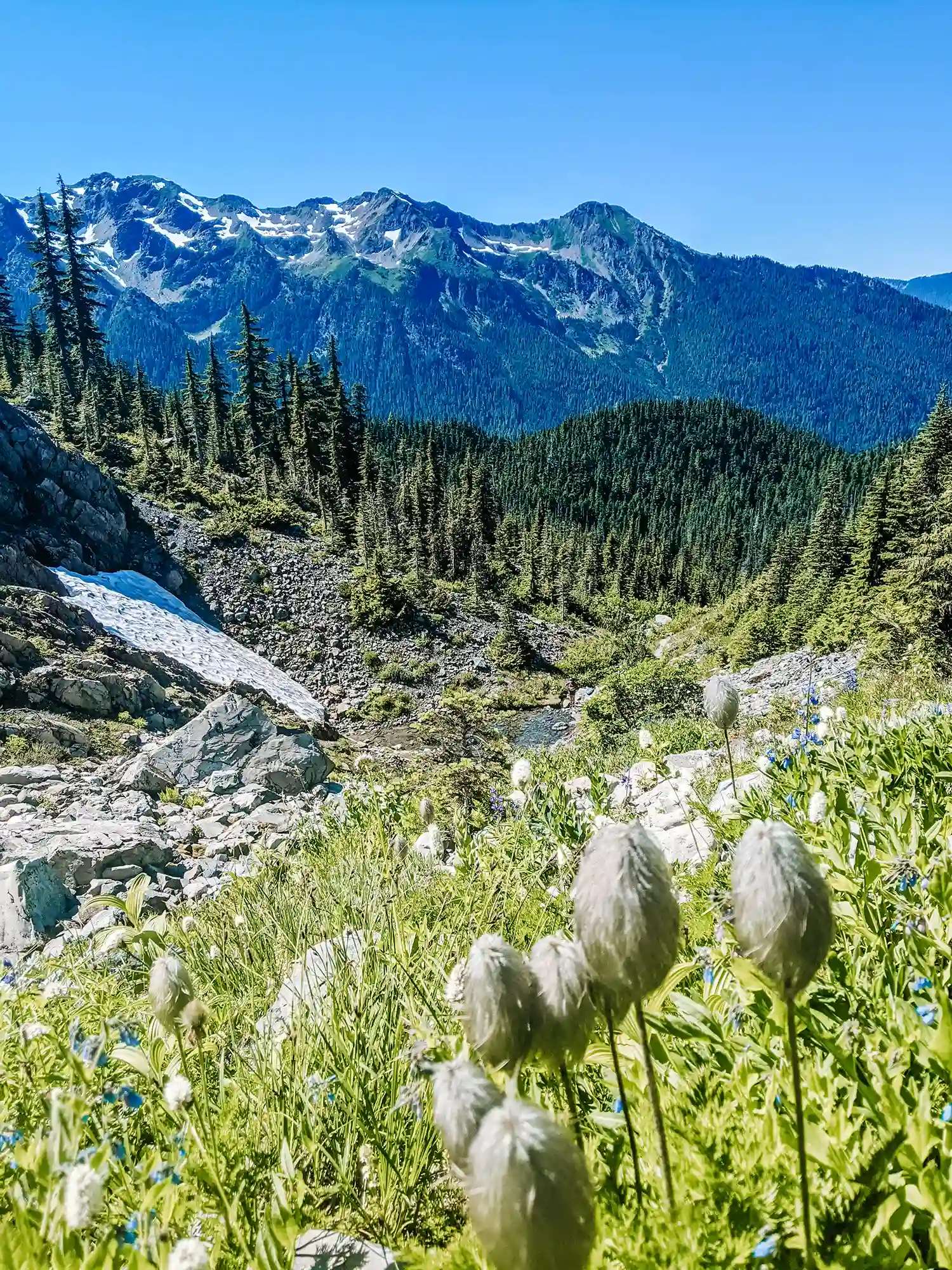
Breath-taking Blooms on Trail
I discovered an array of plants and flowers that were entirely unfamiliar to me, despite having lived in Washington for the majority of my life. The sight of wild lilies, in a form I had never seen before, captivated me completely, instantly making them my absolute favorite flowers.
Above all, the experience ignited all of our senses and truly elevated the experience. Whether it be, the smells of the flowers or watching the butterflies fluttering over the illuminating colors of flowers. Alongside the buzzing bees and trickling streams. It was almost as if I were in a botanical garden. I think the time of year we decided to go, in July, was absolutely perfect!
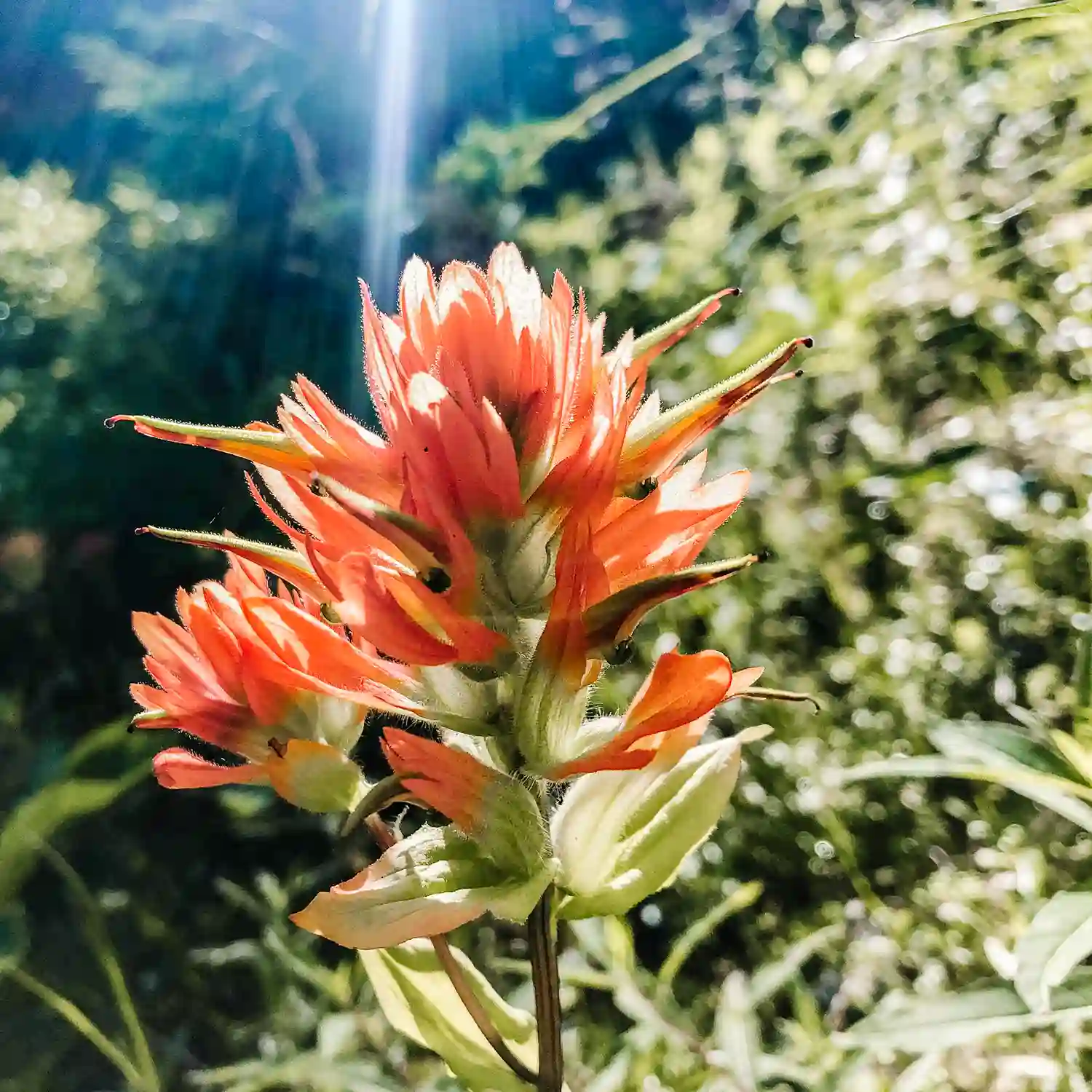
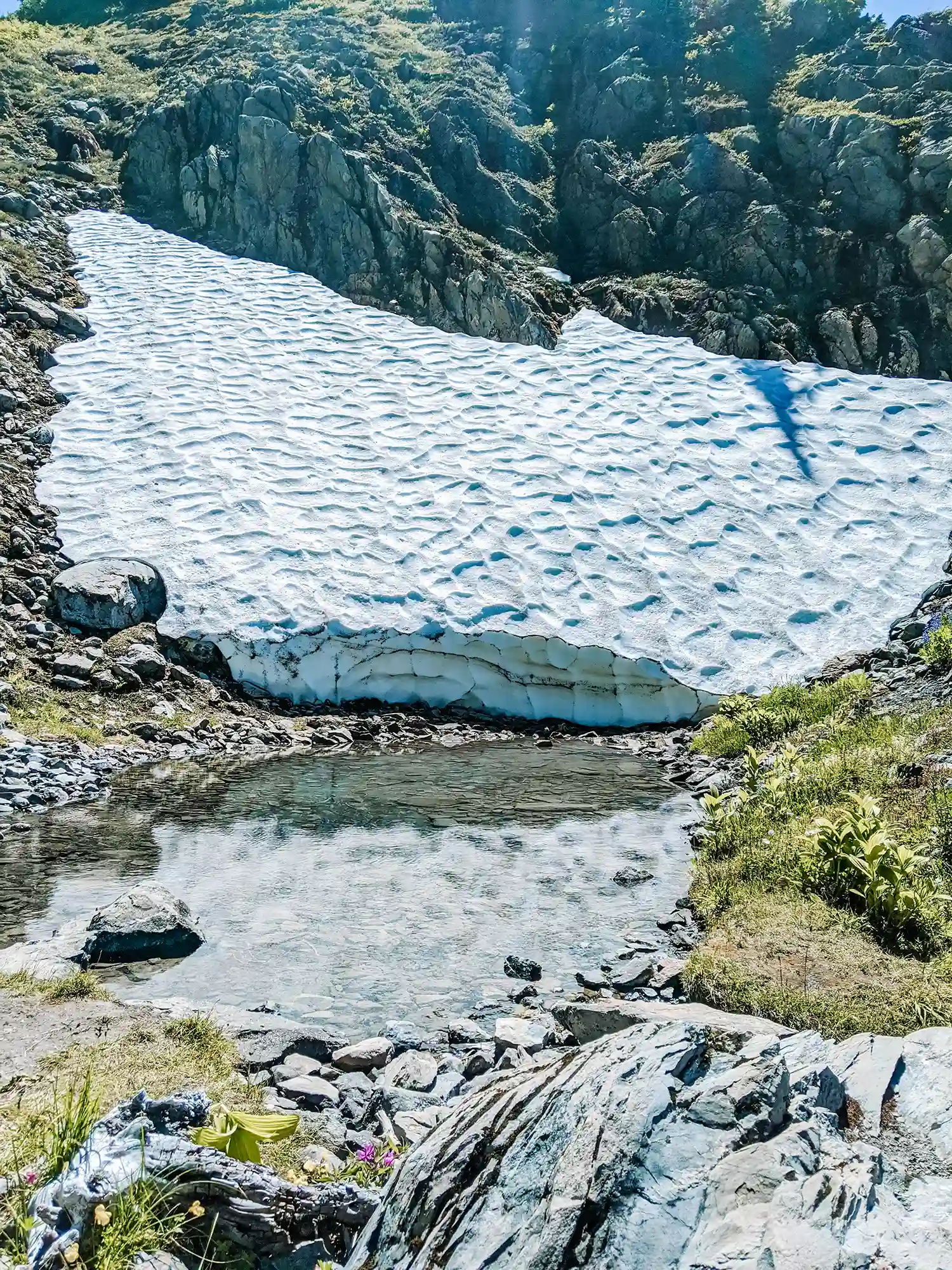
After seeing the glacier basin, we trekked back up that ladder, over the slated rock, and back to Lewis Meadow.

Day 4: Rest Day
Thankfully, we slept on the fourth day, allowing ourselves to load up on calories and recuperate. However, if you’re someone who doesn’t need a rest day, then it’s also totally possible to hike out this day and head back to the car if you want to.
Although, It would be around a 10-mile (16.09 km) hike out. It’s always better to over-plan time than under-plan it, just in case something happens or if you decide to have a rest day! But also take into consideration trek out time, drive time, or ferry schedules.
I’d recommend really caring for the body, and not trying to push too hard! Plus, another aspect of moving a bit slower and resting is to truly soak up and connect with nature, too!
Day 5: Trekking Out
The morning of the fifth day we ended up camping out at Mt. Tom Creek, around 7-8 miles (11.26-12.87 km) from Lewis Meadow. Mt. Tom Creek was around 3 miles (4.82 km) from the entrance, making it so much easier to trek out the next morning!
Especially because we were well rested, drive to the fairy during daylight, and catch an early ferry, as well as had daylight driving home too. Needless to say, I’m a rest-day kinda gal!
Ready to use The guide for Backpacking the Hoh Rainforest?
As you gear up for your expedition, keep in mind that everyone has their own fitness levels. So, be sure to listen to your body and take those well-deserved breaks. Give yourself the time to recharge and replenish, because even the toughest explorers need a little TLC.
Now, here’s the exciting part! When you embark on your adventure backpacking the Hoh Rainforest, don’t forget to tag me and share your favorite moments. I’m eagerly waiting to hear all about the awe-inspiring sights you encounter, the sounds of nature that serenade your soul, and the sheer joy that radiates from your unforgettable experience.
So, pack your bags, lace up those boots, and get ready for an incredible journey through the enchanting Hoh Rainforest. Make memories, embrace the beauty of the wilderness, and above all, stay safe throughout your expedition.
Disclaimer to backpacking the Hoh Rainforest: I had put “about” or “on average” for the miles because the rangers and tracking devices have shown that the mileage on the markers/signs is inaccurate. So please try to use the best judgment in understanding there could be a couple of miles added on to each marker give or take (which is what I tried to account for in my article, giving a little mileage fluctuation)! Especially due to the landslides and terrain differences over the years adjusting the trails a bit!
Ready to backpack more? Check out these other article to support your inspiration!
- PACK LIKE A PRO: THE ULTIMATE BACKPACKING PACKING LIST FOR UNFORGETTABLE ADVENTURES
- SOLO TRAVEL SAFETY PRINCIPLES FOR BEGINNERS
- A GUIDE TO BACKPACKING WASHINGTON’S OLYMPIC PARK – 7 LAKES BASIN HIGH DIVIDE
- A GUIDE TO BACKPACKING & HIKING RINGBOLT ARIZONA HOT SPRINGS
- HOW TO UTILIZE THE BASIC PRINCIPLES OF LEAVE NO TRACE
You May Also Like...
Day Trip Travel In NYC – Manhattan New York
Solo Travel Safety Principles For Beginners
Serenity
Hey there, It's so great to have you here, As a sustainable travel blogger, I try to create original, captivating, and quality content to support and inspire you! So, if you feel called to comment any praise or ideas, I encourage you to. Your input is valuable to me! Pssstttt...Don’t forget to subscribe to the newsletter to get those goodies that are only available to those on the list. I don't want you to miss out on anything! Have a blissfully serene day, and thank you for being here, and I hope to see more of you!♡





Laura
Love this article! Thank you for sharing your experience! Great info and AMAZING photos😀
Serenity
LauraThank you so much for the compliment, it makes my day to hear that.♡